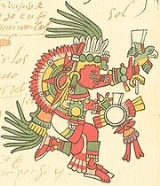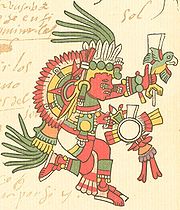
Tonatiuh
Encyclopedia

Aztec mythology
The aztec civilization recognized a polytheistic mythology, which contained the many deities and supernatural creatures from their religious beliefs. "orlando"- History :...
, Tonatiuh (Nahuatl: Ollin Tonatiuh "Movement of the Sun") was the sun god
Solar deity
A solar deity is a sky deity who represents the Sun, or an aspect of it, usually by its perceived power and strength. Solar deities and sun worship can be found throughout most of recorded history in various forms...
. The Aztec
Aztec
The Aztec people were certain ethnic groups of central Mexico, particularly those groups who spoke the Nahuatl language and who dominated large parts of Mesoamerica in the 14th, 15th and 16th centuries, a period referred to as the late post-classic period in Mesoamerican chronology.Aztec is the...
people considered him the leader of Tollan
Tollan
Tollan, Tolan, or Tolán is a name used for the capital cities of two empires of Pre-Columbian Mesoamerica; first for Teotihuacan, and later for the Toltec capital, Tula-Hidalgo, both in Mexico...
, heaven
Heaven
Heaven, the Heavens or Seven Heavens, is a common religious cosmological or metaphysical term for the physical or transcendent place from which heavenly beings originate, are enthroned or inhabit...
. He was also known as the fifth sun, because the Aztecs believed that he was the sun that took over when the fourth sun was expelled from the sky. Aztec cosmology
Cosmology
Cosmology is the discipline that deals with the nature of the Universe as a whole. Cosmologists seek to understand the origin, evolution, structure, and ultimate fate of the Universe at large, as well as the natural laws that keep it in order...
held that each sun was a god with its own cosmic era, the Aztecs believed they were still in Tonatiuh's era. According to the Aztec creation myth, the god demanded human sacrifice
Human sacrifice
Human sacrifice is the act of killing one or more human beings as part of a religious ritual . Its typology closely parallels the various practices of ritual slaughter of animals and of religious sacrifice in general. Human sacrifice has been practised in various cultures throughout history...
as tribute and without it would refuse to move through the sky. It is said that 20,000 people were sacrificed each year to Tonatiuh and other gods, though this number is thought to be inflated either by the Aztecs, who wanted to inspire fear in their enemies, or the Spaniards, who wanted to vilify the Aztecs. The Aztecs were fascinated by the sun and carefully observed it, and had a solar calendar
Solar calendar
A solar calendar is a calendar whose dates indicate the position of the earth on its revolution around the sun .-Tropical solar calendars:...
similar to that of the Maya
Maya civilization
The Maya is a Mesoamerican civilization, noted for the only known fully developed written language of the pre-Columbian Americas, as well as for its art, architecture, and mathematical and astronomical systems. Initially established during the Pre-Classic period The Maya is a Mesoamerican...
. Many of today's remaining Aztec monuments have structures aligned with the sun.
In the Aztec calendar
Aztec calendar
The Aztec calendar is the calendar system that was used by the Aztecs as well as other Pre-Columbian peoples of central Mexico. It is one of the Mesoamerican calendars, sharing the basic structure of calendars from throughout ancient Mesoamerica....
, Tonatiuh is the lord of the thirteen days from 1 Death to 13 Flint. The preceding thirteen days are ruled over by Chalchiuhtlicue
Chalchiuhtlicue
Chalchiuhtlicue was an Aztec goddess of love, beauty, youth, lakes, rivers, seas, streams, horizontal waters, storms, and baptism. Reputedly universally revered at the time of the Spanish conquest, she was an important deity figure in the Postclassic Aztec realm of central Mexico...
, and the following thirteen by Tlaloc
Tlaloc
Tlaloc was an important deity in Aztec religion, a god of rain, fertility, and water. He was a beneficent god who gave life and sustenance, but he was also feared for his ability to send hail, thunder and lightning, and for being the lord of the powerful element of water. In Aztec iconography he...
.

